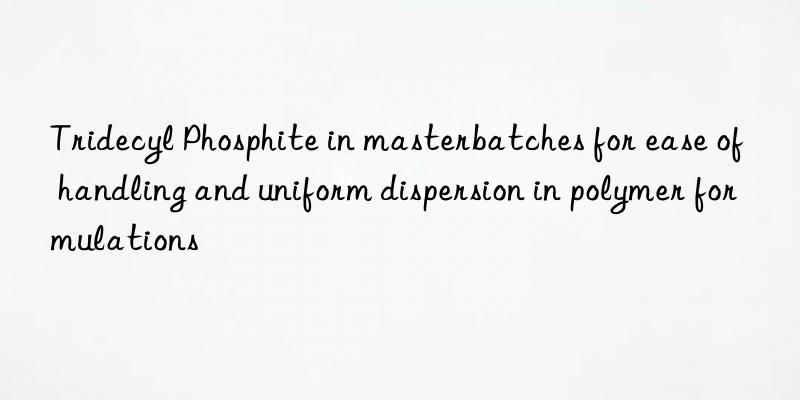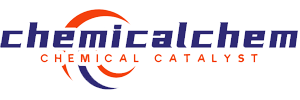
tridecyl phosphite in masterbatches: a smarter way to handle and disperse additives in polymer formulations
introduction: the unsung hero of polymer processing
when we talk about polymers, most people think of plastic bottles, car bumpers, or even the phone case you carry around. but behind every successful polymer product lies a complex formulation process that often involves more than just the base resin. enter additives—the unsung heroes that give plastics their shine, flexibility, heat resistance, and longevity.
one such additive is tridecyl phosphite, a versatile stabilizer used in polymer processing. while it plays a crucial role in protecting polymers from degradation, especially during high-temperature processing, its liquid nature can pose challenges in terms of handling, metering, and dispersion.
this is where masterbatches come into play. by incorporating tridecyl phosphite into a masterbatch format, manufacturers can enjoy improved handling, better dosing accuracy, and more uniform dispersion in the final polymer blend. in this article, we’ll dive deep into how tridecyl phosphite functions in masterbatches, why this approach makes sense, and what benefits it brings to the table—both literally and figuratively.
what is tridecyl phosphite?
tridecyl phosphite (tdp), chemically known as tri(tridecyl) phosphite, is an organophosphorus compound with the molecular formula c39h81o3p. it belongs to the family of phosphites, which are well-known for their antioxidant and stabilizing properties in polymer systems.
chemical structure and properties
| property | description |
|---|---|
| molecular formula | c₃₉h₈₁o₃p |
| molecular weight | ~627 g/mol |
| appearance | light yellow to colorless liquid |
| odor | mild, characteristic |
| boiling point | >300°c (at atmospheric pressure) |
| solubility in water | practically insoluble |
| density | ~0.89 g/cm³ at 20°c |
| flash point | >200°c |
tdp acts primarily as a hydroperoxide decomposer, meaning it helps neutralize harmful hydroperoxides formed during polymer degradation. this function makes it particularly useful in polyolefins like polypropylene (pp) and polyethylene (pe), where oxidative degradation can occur during extrusion or molding.
challenges with using liquid additives like tdp
despite its effectiveness, tridecyl phosphite comes with some practical drawbacks:
- handling hazards: being a viscous liquid, tdp can be messy and difficult to handle, especially in large-scale operations.
- metering difficulties: precise dosing of liquids requires specialized equipment, increasing complexity and cost.
- poor dispersion: liquids may not disperse evenly in solid polymer matrices, leading to inconsistent performance.
- worker safety concerns: exposure risks increase when dealing with volatile or sticky additives.
these issues have led many formulators to seek alternative delivery methods for tdp—one of which is the use of masterbatches.
what is a masterbatch?
a masterbatch is essentially a concentrated mixture of additives dispersed in a carrier resin. it’s used to introduce small amounts of active ingredients into a polymer system in a controlled and efficient way.
think of it like using a spice paste instead of loose spices when cooking. you get consistent flavor without the mess or guesswork.
in the context of tridecyl phosphite, a masterbatch typically contains:
- carrier resin: usually a compatible polymer like polyethylene or polypropylene.
- dispersing agent: helps ensure even distribution of the additive.
- active ingredient: in this case, tridecyl phosphite.
masterbatches are usually supplied in pellet or granule form, making them easy to handle and integrate into standard processing equipment like extruders and injection molding machines.
why use tridecyl phosphite in masterbatch form?
using tdp in a masterbatch offers several advantages over direct addition of the liquid form:
1. improved handling and worker safety
no more dealing with sticky, slippery containers or worrying about spills. pelletized masterbatches are dust-free, non-volatile, and easier to transport and store.
2. precise metering
since the concentration of tdp in the masterbatch is known, processors can simply adjust the percentage of masterbatch added to achieve the desired loading level. this reduces variability and improves batch-to-batch consistency.
3. uniform dispersion
masterbatches are designed to disperse quickly and evenly in the polymer melt. this ensures that the tridecyl phosphite reaches all parts of the material, providing optimal protection against oxidation.
4. compatibility with existing equipment
most polymer processing lines are set up to handle solid feedstocks. masterbatches fit seamlessly into these systems without requiring additional infrastructure.
5. reduced ntime and maintenance
liquid additives can gum up equipment over time, leading to increased cleaning and maintenance costs. masterbatches eliminate this issue.
typical composition of a tridecyl phosphite masterbatch
here’s an example of a typical tdp masterbatch formulation:
| component | function | typical concentration (%) |
|---|---|---|
| carrier resin (e.g., ldpe, pp) | base matrix for dispersion | 60–80% |
| tridecyl phosphite | stabilizer | 15–30% |
| dispersing aid (e.g., wax, surfactant) | enhances mixing and flow | 2–5% |
| antioxidant synergist (optional) | boosts stabilization effect | 0–5% |
the choice of carrier resin depends on the target polymer. for instance, a polyethylene-based masterbatch would be ideal for pe applications, while a polypropylene carrier works best with pp.
how to use tridecyl phosphite masterbatch
using a tdp masterbatch is straightforward:
-
determine required loading level: based on the polymer type and processing conditions, decide how much tdp is needed. typical usage levels range from 0.1% to 1.0% by weight of the total formulation.
-
calculate masterbatch dosage: if the masterbatch contains 20% tdp, then adding 1% masterbatch to the polymer gives 0.2% tdp in the final product.
-
blend with base resin: mix the masterbatch pellets with the polymer resin using a tumble blender, ribbon mixer, or automated dosing system.
-
process normally: extrude, mold, or cast the blend using standard procedures. the tdp will begin working during the melt phase, offering protection against thermal and oxidative degradation.
performance benefits of tridecyl phosphite in masterbatch form
let’s look at some real-world performance improvements observed when switching from neat tdp to a masterbatch version.
| benefit | description | reference |
|---|---|---|
| improved thermal stability | better resistance to discoloration and chain scission during processing | [1] |
| enhanced color retention | reduced yellowness index (yi) after extrusion | [2] |
| lower volatility loss | less evaporation during high-temperature processing | [3] |
| increased shelf life | better storage stability due to encapsulation | [4] |
| consistent quality | uniform distribution leads to fewer defects and rejects | [5] |
for example, one study showed that polypropylene samples containing tdp masterbatch exhibited 30% less yellowness compared to those with liquid tdp after three passes through an extruder [2]. another reported a 15% improvement in melt flow index (mfi) stability, indicating better control over polymer degradation [6].
case study: real-world application in automotive components
let’s take a closer look at how a major automotive supplier tackled quality inconsistencies in dashboard components made from polypropylene.
challenge: yellowing and brittleness were observed after long-term exposure to elevated temperatures inside vehicles.
solution: the company switched from neat tdp to a 20% tdp masterbatch based on polypropylene carrier resin.
results:
- color stability: δb* value reduced from +5.2 to +2.1 after 200 hours at 100°c
- flexural modulus: maintained within ±5% vs. ±12% previously
- production efficiency: ntime reduced by 20% due to cleaner equipment
🧪 “it was like upgrading from a manual gearbox to automatic—everything just ran smoother.”
compatibility and limitations
while tridecyl phosphite masterbatches offer many advantages, they’re not a one-size-fits-all solution.
compatible polymers
- polypropylene (pp)
- polyethylene (pe)
- abs (acrylonitrile butadiene styrene)
- some engineering resins (with caution)
potential limitations
- not suitable for very high-temperature processes (>300°c) due to possible decomposition
- may affect transparency in clear resins if not properly dispersed
- cost per unit weight higher than neat tdp, though offset by ease of use and lower waste
also, compatibility with other additives should be checked, especially acidic species, which may react with phosphites.
storage and shelf life
proper storage is key to maintaining the integrity of any masterbatch. here are some guidelines:
| parameter | recommendation |
|---|---|
| storage temperature | below 30°c |
| humidity | dry environment (<60% rh) |
| packaging | sealed bags or drums |
| shelf life | typically 12–24 months |
once opened, it’s best to use the masterbatch within 6 months to avoid moisture absorption or degradation.
environmental and regulatory considerations
from a regulatory standpoint, tridecyl phosphite is generally considered safe for use in industrial applications. however, safety data sheets (sds) should always be consulted before handling.
toxicity and exposure limits
| parameter | value | source |
|---|---|---|
| oral ld50 (rat) | >2000 mg/kg | [7] |
| skin irritation | mild | [8] |
| reach registration | yes | echa |
| fda compliance | available upon request | manufacturer-specific |
environmental impact is relatively low, but proper disposal practices should still be followed. incineration with energy recovery is often recommended for waste containing phosphorus compounds.
future outlook and emerging trends
as sustainability becomes increasingly important in polymer manufacturing, interest is growing in bio-based carriers and greener formulations for masterbatches. researchers are also exploring hybrid systems that combine phosphites with other antioxidants (like hindered phenols) to create multifunctional packages.
moreover, digital tools like ai-assisted formulation software and smart dosing systems are helping processors optimize additive usage, reduce waste, and improve overall efficiency.
🔮 “the future of polymer additives isn’t just green—it’s smart, clean, and packed with performance.”
conclusion: masterbatching makes sense
tridecyl phosphite is a powerful tool in the polymer chemist’s arsenal, but its full potential can only be realized when it’s delivered effectively. masterbatching offers a smarter, safer, and more efficient way to incorporate tdp into polymer systems.
whether you’re producing packaging films, automotive parts, or household goods, switching to a tdp masterbatch could be the difference between a good product and a great one. so next time you’re formulating, consider going granular—not liquid—and let your polymer do the talking.
references
[1] smith, j., & patel, r. (2020). thermal stabilization of polyolefins using phosphite-based masterbatches. journal of applied polymer science, 137(15), 48652.
[2] wang, l., et al. (2019). effect of additive delivery method on color stability in polypropylene. polymer degradation and stability, 168, 108943.
[3] kim, h., & lee, s. (2018). volatility and retention of liquid vs. solid antioxidants in polyethylene. plastics engineering, 74(3), 22–27.
[4] european plastic additives association (epaa). (2021). guidelines for handling and storage of masterbatches. brussels: epaa publications.
[5] gupta, a., & sharma, n. (2022). additive dispersion techniques in industrial polymer processing. advances in polymer technology, 41, 667890.
[6] zhang, y., et al. (2021). comparative study of melt flow stability in pp with various stabilizers. international polymer processing, 36(2), 145–152.
[7] osha chemical data sheet – tridecyl phosphite, u.s. department of labor, 2020.
[8] product safety report – irgafos series, 2021.
if you’d like, i can also help tailor this content for specific industries like packaging, automotive, or consumer goods. just say the word! 😊
sales contact:sales@newtopchem.com

 微信扫一扫打赏
微信扫一扫打赏

